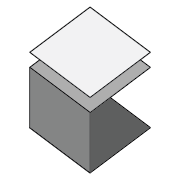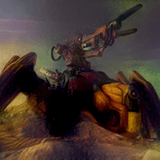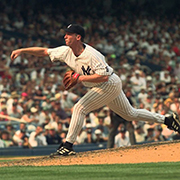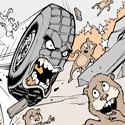|
echinopsis posted:Is there anyone who could guide me into the first steps of making a simple addon for blender? You've probably exhaustively looked into this, but have you checked to see if there's a different undo queue for viewpoint movements? I know Maya used to use the bracket keys to undo/redo viewport movements instead of the ctrl-Z queue.
|
|
|
|

|
| # ? May 28, 2024 12:37 |
|
AFAIK, the camera moves do not count as part of the undo system when done in first person mode or lock camera to view, so itís way too easy to be navigating in first person and forget to hit escape to cancel it. I did see someone mention selecting the camera in the outliner and undoing there, but Iím not at a PC so canít test if it works. If that does, this may be doable with some code, if not, a workaround would be needed. Iím definitely not a good programmer so I donít fully know wtf Iím doing, but in my head it goes something like this (not-code to follow): - assign camera undo keybind - Identify when user enters active camera - when user presses camera undo, select active camera in outliner - run undo step - possibly unselect camera? Code-wise, thereís always some weirdness when it comes to how active objects are handled. Thereís all sorts of context based nonsense, and in a massive script weíve done at work for simulation generation for ML purposes, weíve had to use pretty much every context workaround there is. Cameras might be okay, this stackexchange post seems to reference scene.camera as a way to call active cameras: https://blender.stackexchange.com/questions/8245/find-active-camera-from-python If the outliner trick doesnít work, it might kinda work jankily like so: - assign undo keybind - select active camera - add keyframe - if undo is pressed, revert to keyframe (not sure best method, maybe by jumping back and forwards a frame?) - if enter is pressed, add another keyframe with new data, then delete keyframe I think you could also keyframe in negative frames, and reference those as more permanent fixed angles, but I have a feeling you might not be able to easily reference what keyframe goes with what camera. In the end, itíll be about breaking the action (undo camera) into a bunch of discrete steps, and hunting for the right code for each of the steps. Luckily thereís lots of good resources so bad coders like me can still make things that good coders can fix, but if you donít have a ton of python experience its going to be a bit of trial and error. E: I definitely went overboard on this, rereading original post, if itís literally just unticking ďlock camera to viewĒ, I think you can make a keyboard shortcut for that: https://blender.stackexchange.com/questions/68996/assign-shortcut-to-lock-camera-to-view Or just make a basic script using the code here, that runs when Blender starts: https://blender.stackexchange.com/questions/107029/how-do-i-lock-camera-to-view-using-python Slothful Bong fucked around with this message at 15:20 on Sep 25, 2021 |
|
|
|
Thanks for the help, folks. I was hesitant about the mirroring/rotating approach because the piece does not quite have perfect mirror or radial symmetry. One of the things that occasionally frustrates me about Inkscape (the program I used to draw the snowflake in the first place) is that, as far as I can tell, there's no way to precisely set the origin/pivot of an object to a specific point. So I end up putting a dot on the point I want to use as the center, and then dragging the origin onto that dot as precisely as I can...but there's still noticeable asymmetries if you look closely. And when this thing gets blown up to 8km x 8km in-game, those asymmetries could be significant. But oh well, if there's no easier solution then there's no easier solution.
|
|
|
|
Slothful Bong posted:AFAIK, the camera moves do not count as part of the undo system when done in first person mode or lock camera to view, so it’s way too easy to be navigating in first person and forget to hit escape to cancel it. Yeah this video shows the outlined tip working https://youtu.be/tFVukCHJW1A
|
|
|
|
My big tutorial is done! https://i.imgur.com/cemt6sR.mp4 It covers painting out bits of footage and crane removal - but the technique is also useful on finished full CG shots and has a ton of other applications too. Part of the motivation to create this came from speaking to people about AE vs Fusion, and people who use AE on a regular basis simply not knowing why theyíd ever use fusion (or nuke), or what node based compositing offers over AE. That is to say - if youíre thinking ĎI dont know why iíd need to know thisí, maybe give the first 10 minutes a shot anyway - youíre the exact target audience. There is no rotoscoping or intense frame-by-frame animation required, and it can be done in the free version of fusion. Itís also relatively simple to do this in nuke if youíre familiar with all of itís tools. Here is the link! https://www.youtube.com/watch?v=I4QzB7tT6zQ The technique goes back to something I bumbled my way through with the help of some people on the vray forum 12 years ago, and shortly afterwards got refined and moved over to fusion 6. (the first time I did this was all in maxÖ rendering out entire sequences!) It seems like this approach is definitely underrepresented in tutorials, and so I felt it was a good subject to cover. I would not be where I am without endless free tutorials, other people sharing knowledge and having been on communities/forums my entire career. hopefully, this will help some others to do better, cleaner work. While it is long, it is intended to be extremely comprehensive. The technique is covered in the first 20 minutes, then the remainder of the video goes into a practical large scale application of this - and after iím done, a bit of an overview of the pros and cons of various areas. Itís broken up into chapters for easy reference - ideally, after watching, youíll understand the application and where it will be good to use, then when you come to pull it back up as a production reference Ďon the jobí, however long later that is, youíll be able to jump to a specific chapter. Itís not a day-to-day technique, but it turns what is an absolute pain in the rear end job using AE into something that is easy, flexible, and quite enjoyable to work on. If you get 20 minutes in and think this is something you could use, I would recommend watching it in full before trying to Ďfollow alongí on a live project - there is some insight towards the end when iím covering the finished document about what worked well and what I had to fight with a little. I tried to cover every single application and thing you might encounter in the same project, but it did cause a few challenges that could have been avoided (but then, i wouldnt have been able to show working around them...) I sincerely hope people are able to enjoy or get something meaningful from this. I imagine there are more ways this can be refined further - if it does spark an idea or you have a way to take this even further, iíd love to hear about it. You may also notice itís being hosted on a DBOX ĎDialogí channel... Thereís a good chance there will be more of this - covering less obvious & underutilized production workflow tutorials. cubicle gangster fucked around with this message at 00:13 on Sep 26, 2021 |
|
|
|
TooMuchAbstraction posted:Thanks for the help, folks. I was hesitant about the mirroring/rotating approach because the piece does not quite have perfect mirror or radial symmetry. One of the things that occasionally frustrates me about Inkscape (the program I used to draw the snowflake in the first place) is that, as far as I can tell, there's no way to precisely set the origin/pivot of an object to a specific point. So I end up putting a dot on the point I want to use as the center, and then dragging the origin onto that dot as precisely as I can...but there's still noticeable asymmetries if you look closely. And when this thing gets blown up to 8km x 8km in-game, those asymmetries could be significant. But oh well, if there's no easier solution then there's no easier solution. Recreate the symmetry in blender. Delete all but one segment, then delete one half of it (looks like you have mirror symmetry within each radial segment). Place the origin precisely at the world origin, and use grid snapping edits and precise-angle rotations to get every vertex where it needs to go. Turn on merge in your mirror modifier. Add an array modifier, set it to object offset to a new empty that you place at the world origin. Rotate the empty by precisely 60 degrees. Turn on merge. https://docs.blender.org/manual/en/latest/modeling/modifiers/generate/array.html Now duplicate the whole object, with modifiers, and chop up the geometry to make your colliders - you'll only have to do that work on 1/12th of it now. e: made a little video since this might not be clear https://i.imgur.com/silJUmz.mp4 Taffer fucked around with this message at 18:58 on Sep 25, 2021 |
|
|
|
Taffer posted:Recreate the symmetry in blender. Yeah, I guess recreating things using the vector art as a guide is the right solution.  Thank you for the video! It's a concept I'm familiar with but haven't really ever seriously used. Thank you for the video! It's a concept I'm familiar with but haven't really ever seriously used.
|
|
|
|
BonoMan posted:Yeah this video shows the outlined tip working if this works then this solves my problem, thanks slothful bong - my problem is that itís a tick box I find mega useful but forget to turn off for whatever reason so I wanted a time based thing, where itíd untidy itself a couple mins after being ticked. even a script lol that unticked it every couple mins regardless but redundant if that trick works
|
|
|
|
God, working on this thing is a trip 
|
|
|
|
This IATSE strike thing is looking more and more likely. Wondering what the effects will be on the vfx and animation industry? I thought it might just affect VFX, and only for projects that haven't finished filming yet. But then someone pointed out that if the editors go on strike, there's no one to present dailies to the directors. And the directors also won't cross the picket line. So that means in animation too there won't be editors to show stuff to clients. I've got friends working on animated series for directors who are part of the Directors Guild of America, if they won't cross the picket line, that whole show grinds to a halt even though its fully animated, no live action. Pretty much the only people who would be safe are those working on wholly Canadian productions, where the showrunner isn't in LA or something. As soon as you involve anyone in LA who has to approve stuff, even if it's a client or network, the show can't continue. At least that's my (admittedly pessimistic read) on it.
|
|
|
|
Why are you pessimistic about a strike? Strikes are good. Don't cross the picket line.
|
|
|
|
Taffer posted:Why are you pessimistic about a strike? Strikes are good. Don't cross the picket line. I'm fully in favor of the strike, IATSE deserves to get what they're asking for. Those of us in VFX and Animation getting laid off until things resolve and not seeing any benefit to the new deal from IATSE (because we're not part of any union because our industries suck at that) isn't such a fun prospect. Ideally a positive Strike Authorization vote would scare the studios so much that they agree to the new IATSE deal. But they might try and call what they see as a bluff and be willing to forego new content for a while, believing it would cost more in the long run to agree to IATSE's terms. Of course if they weren't suck greedy fucks they'd just have agreed to IATSE's terms in the first place and this wouldn't have gotten so far, but when have giant corporations ever not been greedy? Ccs fucked around with this message at 17:03 on Sep 27, 2021 |
|
|
|
ZBrush curve brush question... I have a brush for putting stitching in on a mesh. It's this one from Badking. Okay. If I try and get it to follow the mesh all the way around...  ... when I let up, it's clipping into the model. Then when I try nudging stuff around it still doesn't really sit right on the surface of the mesh.  What am I missing here to make this work right?
|
|
|
|
My office in the Uncanny Valley
|
|
|
|
I can kinda understand 3d modeling, because it's building stuff, and you see someone model and it's like "well, not sure what tools/keys he's using but yeah, that part connects here, bend it, etc" I took a peek at rigging, that stuff is some forbidden dark magic
|
|
|
|
Comfy Fleece Sweater posted:I can kinda understand 3d modeling, because it's building stuff, and you see someone model and it's like "well, not sure what tools/keys he's using but yeah, that part connects here, bend it, etc" Are you talking about the math underlying how rigging works, the process for setting up a rig, how you use a rig once it's set up, or what?
|
|
|
|
Harvey Baldman posted:ZBrush curve brush question... Probably a smaller brush initially before drawing the curve. The size of the brush has a direct influnce on the size of that dotted line. The dotted line is everything. You can move it with the light blue cursor. You can smooth it AFTER moving it with the light blue cursor using shift. You can even TWIST it by using the control key after moving. Adjust your brush size and click back on the curve to adjust the size of the tube or uh... stitching in this case. Once you get as close as possible split the stitching using split -> split unmasked points. Then use the move or move topo brush or even move elastic to move the stitching back into place. The move elastic brush probably being a little over the top here. Usually I only use move elastic on hair to throw it around loosely. Inflate may be another option but that will inflate each segment of the thread, which is probably not what you want. Try to get most of the way with the curve tool if you can. Remember you can extend the curve by getting close to either end until the red line pops out. Then continue the curve vs. holding down the shift button to make a perfect circle. You get more control if you extend the curve all the way around yourself vs. holding down shift to make closed loop.
|
|
|
|
TooMuchAbstraction posted:Are you talking about the math underlying how rigging works, the process for setting up a rig, how you use a rig once it's set up, or what? All of it! I mean mostly creating a rig, using them is easy (thatís the point I imagine) Baby stepsÖ
|
|
|
|
Rig building is largely semi-automated these days.
|
|
|
|
Unless this is what you need to rig - https://m.youtube.com/watch?v=SfExejqdr5w
|
|
|
|
As someone who hasn't kept up with modern techniques, I stick to rigging machinery as much as possible. Life is a lot easier when your model assigns each vertex to exactly 1 bone, with a weight of 1.
|
|
|
|
cubicle gangster posted:Unless this is what you need to rig - https://m.youtube.com/watch?v=SfExejqdr5w I consider myself a fairly technical person but I find this one difficult to fathom. That 'humanoid' pose is bonkers. Also for anyone who isn't aware of this, most of the motion designers I know use Mixamo to rig and animate characters. Results aren't perfect, but it's a good option for indie devs/artists who don't want to burn up all their time on character animation.
|
|
|
|
cubicle gangster posted:Unless this is what you need to rig - https://m.youtube.com/watch?v=SfExejqdr5w Right, but you'll still get most of the default behaviour from rig building tools. Admittedly, I haven't kept up. I switched from rigging to FX some 15 years ago 
|
|
|
|
ImplicitAssembler posted:Right, but you'll still get most of the default behaviour from rig building tools. Admittedly, I haven't kept up. I switched from rigging to FX some 15 years ago Yeah, this is definitely more of a logistics & planning challenge, I just saw it recently again and thought it was worth sharing! I'm pretty happy with how that tutorial is going over - I only shared it to my personal facebook, here, and a couple of other forums. After 3 days it's up to 1100 views with a huge number coming from whatsapp, gmail & slack, which means people are sharing it with each other. Viewer retention is surprisingly good too - 40% of the people who make it past the first minute stick around for at least 20. Analytics are great!
|
|
|
|
I'm a motion designer, but I'm a bit stumped on ways to go right now. Most designers worth their salt know 3D and I'm finding it a bit daunting. For background, I have used Cinema 4D (particularly the lite version) for a while but no external render engines and nothing complex. Mostly just 3d text and simple animations. In the background, I started learning a bit of blender and was surprised what you get for free. Fluids seem a bit buggy though. The angles I have been considering are: C4d and octane (paid) C4d and redshift (paid) Blender (free) Blender and octane (free) (I hear octane is free for blender, you can only use one GPU which is fine for me) I'm sure using Blender will lock me out of studio work (at least the bigger ones). Blender is good, but I have to keep notes of all the shortcuts, how to use nodes and stuff. Cinema4d, I never forget the workflow. Anyone made the jump to Blender from another app? Just curious if it's actually sensible to do so. I'm sure in the end the client doesn't care what you use but given the amount of time you have to put into learning it I'd love to hear people's opinions.
|
|
|
|
You're already fully in a motion designer career? stick with c4d - you might want to be able to get freelance work from someone who needs an extra pair of hands. C4d is loaded with mograph specific tools too. Blender is great and everything does translate to other software, but it's best for someone dipping their feet in without a career path in mind already. Fantastic tool for hobby/personal work, and worth having alongside your main. I dip into it once every few weeks for the things it handles better than max, but my industry is max and any new hires are essentially a junior until they become proficient - ability to hit the ground running does affect people's ability to negotiate a salary.
|
|
|
|
I got a new job! And it ties into the Blender vs other conversation. Started as a surfacing lead Friday at a larger boutique VFX studio thatís primarily Maya. Up until this, Iíve mostly been Blender for work. But Iíve used Maya in the past, and even though Iím somewhat rusty itís mainly in ďwhere is this specific featureĒ or ďwhat does Maya call it?Ē This gave me the confidence to swing for the job even though I have limited production experience with it. Because for modeling and surfacing (and probably other skills as well), much of the knowledge is platform agnostic, with the majority of skill coming from learning the quirks and tricks of the programs. In fact, the biggest thing has been getting a handle on all their custom pipeline tools, and those are unique to the studio. Thatís not to say going to or from Blender is ideal - but learning at least the basics of multiple DCCs means you can adapt a lot quicker to new software when the need arises. Same goes for render engines - theyíre all sorta similar under the hood, just with different shader setups and render settings. So if you learn a couple, you can pick up new ones quickly.
|
|
|
|
Congrats!!
|
|
|
|
the_lion posted:I'm a motion designer, but I'm a bit stumped on ways to go right now. Most designers worth their salt know 3D and I'm finding it a bit daunting. I went to school for 3D animation, then got a job in Mograph (where I used Maya as 3D supplementation) for about 10 years. Now Iím a creative director and still do mograph but have tried to move myself to being more 3D centric. The best advice Iíd give someone in your position is to use C4D with either Arnold or Octane and then subscribe to GreyScaleGorilla Plus ($50/month) to help you elevate your game immediately. Blender is great, a couple of folks use it here in our studio (That Iím new to, just joined in April), but it really shines when you have lots of free time to invest or are in an environment that has completely embraced it. And honestly itís not *better* than C4DÖ itís just free. So to have the best compatibility with other people, Iíd say use C4D. The 25 release is frickiní great and it just keeps getting better. And, I promise Iím not a paid sponsor of GSG Plus, but holy poo poo it just gets you to 2nd base immediately. Just amazing mograph centric training (and tons of it) and amazing plugins and materials/hdri packs etc. Itís worth way more than it costs. Also their training focuses on Redshift, Arnold and Octane so you can find out which one is best for you. All of those renderers can produce great results, but when I look at artist friendly renderers with UIs and workflows that just make sense, I feel like Arnold and Octane are the best. Arnold was the #1 for me (I started on v6 though so I never had any of the earlier issues with it). Itís fantastic. My new place uses Octane so I took the opportunity to get in on that and I loved it immediately too (Arnold still takes the edge for me). And at the end of the day, Blender and C4D are getting very similar so I think switching between those two shouldnít be an issue. Okay TLDR edition: If you need to get up and running quickly, C4D will allow you to plugin to more workflows easier than any other programs in the mograph world. Itís design is almost entirely mograph centric now. GreyScaleGorilla + will get you instant access to tons of rock solid training centered around MoGraph and paired with some amazing plugins that will get you far along *very* quickly. Hit me up with any questions or whatever! Iím not an expert, but part of my everyday existentialism is figuring out how to update my 3D/C4D game in the mograph field. And Iíve been doing it for almost 15 years now lol. Edit: also in the new r25 release of C4D, the node capsules are amazing. I think the node based workflow was cool (but never saw how I could use that as my primary workflow in a 3D environment), but the capsules I think is going to take a huge hold in the mograph world. It basically takes the non-destructiveness that Nodes gives you and packages them up into little modularÖ capsulesÖ that you can plugin to your animation and do really cool non-destructive poo poo. Also do you have a reel or anything? And where are you located? Weíre looking for a 3D/2D person! BonoMan fucked around with this message at 18:01 on Oct 2, 2021 |
|
|
|
the_lion posted:For background, I have used Cinema 4D (particularly the lite version) for a while but no external render engines and nothing complex. I'd personally recommend trying Octane if you've never used a third party render engine before. I think you might be surprised how easy it is to use. In my experience it's the engine that looks the nicest out of the box without you really having to do much at all. I can remember the first time I started using it. Up until that point all I really knew was C4D's standard/physical renderers. Using Octane felt like someone just handed me cheat codes.
|
|
|
|
500 posted:I'd personally recommend trying Octane if you've never used a third party render engine before. I think you might be surprised how easy it is to use. In my experience it's the engine that looks the nicest out of the box without you really having to do much at all. It's pretty drat awesome. I had already started on Redshift (didn't love it), then moved over to Arnold 6 (loved it) so it wasn't the hugest jump but it's still great. It's very easy to use!
|
|
|
|
BonoMan posted:It's pretty drat awesome. I had already started on Redshift (didn't love it), then moved over to Arnold 6 (loved it) so it wasn't the hugest jump but it's still great. It's very easy to use! Yeah I gave Redshift a go. Also wasn't a huge fan. For some reason I want lots of control in my 3D software (i.e. Houdini), but with render engines I prefer something that gets me fast results. Haven't tried Arnold yet so can't comment on that one unfortunately! I still remember the moment I discovered Octane. I was at Semi-Permanent watching Raoul Marks talk about how he made the opening titles. At the time I was still a beginner 3D guy, so seeing him use the live viewer was a massive "oh poo poo this sort of thing exists?" moment for me.
|
|
|
|
Great advice guys on Blender vs C4d guys, thanks heaps! GSG plus is not something I'd even though about, nor had I considered Arnold. Octane was at the top of the list because people said it was often the fastest which might be best for me given short deadlines.BonoMan posted:
I'm not sure that I'm what you'll be looking for, but I'm in Australia and my reel is at https://www.ryanbarlin.com/motion
|
|
|
|
the_lion posted:Great advice guys on Blender vs C4d guys, thanks heaps! GSG plus is not something I'd even though about, nor had I considered Arnold. Octane was at the top of the list because people said it was often the fastest which might be best for me given short deadlines. Octane will be the fastest to get you too a good luck, but Redshift is considered the fastest overall for production-ready rendering. But I just am not a fan and wouldn't switch over to it. Arnold 6 has live preview and GPU rendering like Octane plus it just has a bit more finesse in it's design and a steady/stable Autodesk backing, but overall I'm loving Octane and it feels the most artist-friendly out of the three (but Arnold was definitely a close second for me... it's improved a lot over the past two years). And thanks for the reel - Australia is too far for us unfortunately but some strong work (although you could probably shorten it by 30 or so seconds and the music is a little much!)
|
|
|
|
I'm also deciding between Octane and Arnold. Isn't arnold really slow? And their GPU version is almost there but not quite?
|
|
|
|
KinkyJohn posted:I'm also deciding between Octane and Arnold. Isn't arnold really slow? And their GPU version is almost there but not quite? Their GPU rendering is definitely relatively new but it was good when I tried it. No idea about speeds on non realtime renders as I only used GPU, but I never felt like speed was a bottleneck. Obviously project type and hardware will decide that Honestly at this point as much as I actually really do like arnold, if you are an individual and not in a production environment then I would probably just get octane for sure. It's really good. BonoMan fucked around with this message at 20:39 on Oct 3, 2021 |
|
|
|
Ccs posted:So Iím going back to vfx from cartoons now that filming is happening again and productions are running, but now I see a possible IASTE strike is on the horizon. Do those in vfx think the strike will affect footage being delivered to vfx houses if it happens? Or it wouldnít be an issue for a year or so because all the projects that are going to be in post production are already finished filming? Probably it poses a slight threat... if it includes a writers strike too that could mean all animation and vfx is affected. If its like anything in the past there will be a stockpile of films/shows in the can ready for post, unless some aspects of that show in post are IATSE members. Eg. For TV/Streaming/Feature Animation, Disney/Nick/CN/etc key parts of productions will be under IASTE membership so I can see that impacting Burbank based but outsourced to Canada animation production. I'm assuming The Animation Guild / IATSE 839 will join a broader strike... On a side note, I see that Titmouse Vancouver unionized, good for them, they were working longer hours than I was at Image Engine across the street from their studio at the time... I was at least getting double time.
|
|
|
|
I'm learning video game character creation and I've just retopo'd my first model using Retopoflow. I'm sure folks itt have already heard of it but I'm plugging it anyway. If you have to retopo anything get this tool it's awesome: https://github.com/CGCookie/retopoflow Before I installed this I spent 3 hours fiddling with vertices just to make the eye mask, but after I figured out how to use this tool I managed to do the entire torso and limbs in 3 hours.
|
|
|
|
Weird, it seems that there is no way of using the raw rgb data of a pixel in blender if the pixel's alpha value is 0, the pixel just becomes black. If I set the image's alpha mode to none (in the UV editor for example), then I get the actual color of the pixels. But then I can't use the alpha of the texture without adding the same texture a second time with the alpha enabled.
|
|
|
|

|
| # ? May 28, 2024 12:37 |
|
Can someone explain to me why the normal maps exported from Maya to Zbrush look terrible? Is there something I am missing when baking out the map? They look absolutely fine in Keyshot but the exact same map looks like ca ca in Maya / Arnold. It's very frustrating and weird. A long time ago someone said normal maps were not really standardized industry wide. Is that still the case? Why would the seams look so terrible in Maya / Arnold and completely invisible in Keyshot with the same normal map exported from zbrush?
|
|
|






























